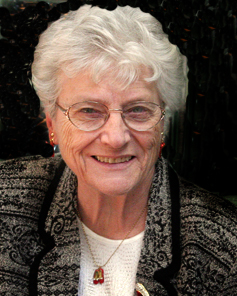
The following article is part of the Diamond Club Member group that began in the January 7, 1943, issue of the Rock County Star Herald. Members of this group consist of persons of age 75 and older.
This article appeared in the April 29, 1943, edition of The Rock County Star Herald.
A resident of Rock county since 1909, and a resident of Luverne since she and her husband retired from farming a number of years ago, Mrs. William Schneekloth, Luverne, says she likes this community better than any community in which she has lived.
She was born in Scott county, Ia. Oct. 12, 1886, the daughter of Henry and Sophie Miller. The fifth of a family of eight, she was given the name Mathilda. She spent all of her girlhood living at home, and because she had four brothers and a sister older than herself, she states she was relieved of much of the hard work that most youngsters of that era had to do. Even then, however, she was called on to do work out of doors as well as indoors. When she became old enough to do the heavier tasks about the farm, she and her sister were required to do the milking. Between them, they milked as high as 16 head at one time, taking it as a matter of course, much the same as the modern girl makes her regular trip to the beauty shop.
The Miller family lived about two miles away from school, and Mrs. Schneekloth states that most of the time, she and her brothers and sisters walked every morning and evening. “In those days, it didn’t seem to be so particular if one went to school or not,” Mrs. Schneekloth states. “When we weren’t busy and needed at home to help with the work, we’d go to school, but work always came first. No one ever permitted his education to interfere with his homework.”
Home economics during the time Mrs. Schneekloth was a girl was taught either in the farm home kitchen or in the dining room or living room where the sewing table was kept. Keeping a family of eight children in clothes, to say nothing of herself and her husband was no small task for her mother, and Mrs. Schneekloth helped her with much of the work as soon as she was old enough to do so. “We not only made clothes for the girls and for the smaller children, she states, but for the men folks too. Buying everything ready made was unheard of at that time,” Mrs. Schneekloth states.
Even after ready made dresses came into their own, she continued to make her own clothing. “When we celebrated our silver wedding anniversary 27 years ago, I still hadn’t had a store dress,” she declares.
Cooking and baking too were learned not for the sake of convenience, but because of necessity. A large family, especially where grownups and young folks alike spend a good deal of the time in the out of doors, requires good, substantial food and plenty of it. Being one of the older girls, she learned at an early age to bake and prepare meals.
When Mrs. Schneekloth was about 13, she had to quit school and come home to “learn how to make good bread for the rest of the family.” Her mother was seriously ill, and being the oldest girl left at home, the burden of the housework fell on her shoulders. Mrs. Schneekloth’s mother died some time later, and from that time until she was married, she was family cook, baker and housekeeper.
The hardest work she has ever done, she relates, is helping the men during the haying season. Often times she helped to level the hay and push it back into the corners of the hay mow after it had been hauled in. On a hot day, pitching hay inside where there was little ventilation proved to be as difficult a job as any she has ever tackled, she states.
(More of Mres. Schneekloth's story in next week's Star Herald.)



